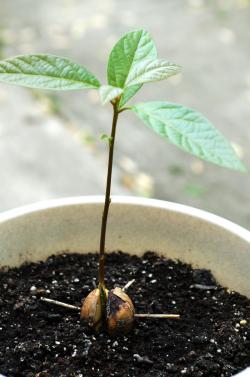January 20, 2018
From Pit to Tree: Starting Houseplants from Food Waste
Question:
I’ve sprouted an avocado pit, and now it’s a small tree with large leaves. Can I acclimate it to the summer heat and bring it in for winters, or is this an indoor plant?
- John M., Farmington, NM
Answer:
You are right that you will need to bring your avocado tree inside during winters in Farmington (and all over New Mexico). Be gentle during the transition when you move it outside for the summer and back inside next fall. Many of my houseplants thrive when I move them to a shady place in the yard each spring. Others, however, do not fare so well. The cold spring nights, even after danger of last frost, can be too much of a shock and cause leaves to drop, not to mention the wind. I practically cried when I took my prized bougainvillea outside after a long, cooped-up winter and within a few hours, all of the leaves were gone with the wind.

Even though avocados are, in nature, large tropical trees, they can be grown indoors as an ornamental in a greenhouse or well-lit space. It will be difficult for the tree to get large enough to produce fruit.
For readers wanting to start their own avocado tree from a pit, here are some pointers. You can just plop the pit down in good, sandy potting soil and wait. To keep from forgetting to water, you can add another small plant or cutting to the pot. It may take up to several months for the seed to germinate and grow, so be patient. If the "wow factor" of seeing the pit split and roots develop is what you're after, you can also do the toothpick method in a clear drinking glass filled with water for maximum visibility, and then plant the seed in soil after root emergence. Stick three toothpicks into the sides of the avocado pit, and place the apparatus in the glass so that the wide end of the seed is touching water.
Back in September 2000, a reader wrote to this column with questions about his 12-year-old avocado tree, so growing an avocado tree indoors for an extended period is possible. I wish we had photos of that plant!
Other food waste that you can grow into houseplants includes potato pieces with eyes, the base of a celery stalk, and even pineapple tops. Three or four years ago, I kept the top from a delicious pineapple, let it soak in water for a week, and then planted it in a pot. During the soaking week, I changed the water out daily as the fruit portion of the base deteriorated. Now I have a lovely pineapple houseplant that I bring indoors each winter. I don't expect it to ever bear fruit, but my aunt's plant did bear an adorable miniature pineapple fruit on a stalk from her planted pineapple top after a few years of care.
How many houseplants do YOU have? Email me the number of houseplants you have at desertblooms@nmsu.edu. I will send cuttings from my houseplants to a randomly selected winner. No houseplant purchases are necessary to win. Full disclosure: At my house, I counted 29 containers, many with multiple species snuggled in together for companionship.

Marisa Y. Thompson, PhD, is the Extension Horticulture Specialist, in the Department of Extension Plant Sciences at the New Mexico State University Los Lunas Agricultural Science Center, email: desertblooms@nmsu.edu, office: 505-865-7340, ext. 113.
Links:
For more gardening information, visit the NMSU Extension Horticulture page at Desert Blooms and the NMSU Horticulture Publications page.
Send gardening questions to Southwest Yard and Garden - Attn: Dr. Marisa Thompson at desertblooms@nmsu.edu, or at the Desert Blooms Facebook page.
Please copy your County Extension Agent and indicate your county of residence when you submit your question!